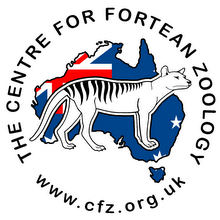In November, the CFZ launched a project to find evidence for a surviving population of Thylacines in Tasmania, Australia.
A team of 10 – five from the UK, five from Australia – went ‘in search of’ the Tasmanian Tiger, the first of several planned expeditions over a two-year period.
While we’ve had a few bouquets and ‘good onyas’, we’ve also received a few brickbats and nasty asides, which is mildly amusing all things considered.
We've even spent some time in the past few days directly responding to some of these ill-founded criticisms.
So here are the general criticisms and our responses to them, to save us time, as we won’t be visiting every cyber bolthole to personally respond to critics or address inaccuracies.
~~~
Criticism: It was a success, when clearly it wasn’t.
We never claimed it was! Put it down to journalistic licence – not everything you read is going to be verbatim, folks.
The journalist made the quote up (Wow, really? Never!). Her original question was “So it wasn’t a roaring success, was it?” His reply: “If you judge the word success as having a body or video of the animal as success, then no, our trip was not a success, but it was successful in that we collected many recent eyewitness statements and some scat for analysis.” (Not verbatim, but you get the drift.)
This trip is merely the first stage in a series of largely self-funded trips to be conducted over the next two years to gauge whether there is sufficient evidence of the Thylacine’s survival.
You can read our aims here: http://www.cfzaustralia.com/2013/10/toyota-backs-biggest-search-yet-for.html
Criticism: You created the perception that outsiders (outside Tasmania, that is) are coming to solve the mystery!
No, we didn’t. We have been liaising with some Tasmanians for many years. We have travelled down almost every year for the past eight years or so.
This is a wildlife mystery that transcends state lines and international borders.
We can’t control media interpretations or individual perceptions.
No, we haven’t.
We have been at pains to continually mention the work of countless other researchers including some of the luminaries in the field – David Fleay, Stephen Sleightholme, Eric Guiler, Heinz Moeller, Col Bailey, Bob Paddle, and Nick Mooney, to name a few.
Indeed, we are referring to their knowledge to inform what we are doing for our own project.
The media edit, omit and relay information as they see fit – we have no control over the final news product.
We would have loved to stay longer but we are all governed by financial obligations and mundane work-a-day concerns. This was the first of many trips over a two-year period.
Anyone want to sponsor us for some fulltime research? ☺
Criticism: We had too many people, or we didn’t have enough people.
The number of people on the trip is really irrelevant – members were split into teams to canvass areas, set up camera traps and interview witnesses.
There was not, as some people might imagine, a conga line of cryptozoologists shuffling through the Australian bush.
Criticism: We didn’t have the right background/expertise/knowledge to be undertaking the expedition.
Bear in mind that many of the great zoological rediscoveries of ‘Lazarus’ species (those species labelled extinct that have been ‘rediscovered’) have been made by everyday people, including naturalists (surviving night parrot population), fishermen (coelacanth, subsequently handed to a museum curator), teenagers (the Bermuda petrel was found by a 15yo boy, and subsequently a naturalist and ornithologist), and bushwalkers (the NZ Takahe was discovered by a bushwalker who also happened to be a doctor of medicine).
Many if not all scientists are at some stage informed in their discoveries by the knowledge of local people who are aware of the species but have felt no need to either classify them or study them in-depth. Seldom are these discoveries the work of just one person.
The team collectively is well read on the subject of Thylacines, have studied the scats and tracks of Australian (and in particular Tasmanian) wildlife, and plotted maps of contemporary sightings to inform the direction of the project.
The team is also liaising with scientists and other naturalists over any interesting discoveries we come across.
Like any good expedition, it’s all about teamwork both within and beyond the immediate team of people who travelled to Tasmania.
~~~
If you think you can do better by all means get involved – the more the merrier, and we just might collectively achieve something great!
If you think it’s all a waste of time, well, that’s fine too. But don’t waste your time or ours by moaning about it and expecting a reply.
In the meantime, we’ll just get on with it. As I’m sure every one of you has had personal experience of by now, the Internet can be a fantastic time sink.
Better we all spend our time doing something rather than just talking about doing, or rubbishing those out there who are doing. We're not the only ones out there looking, after all :-)
And to our loyal readers, supporters, and peers – thanks for rallying behind our multi-faceted project. Let's hope some good comes of it.


Great post! These critics might learn something for a change!!
ReplyDelete